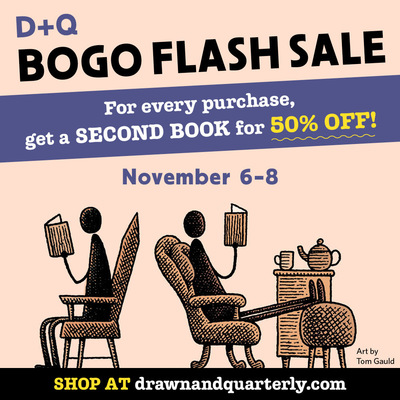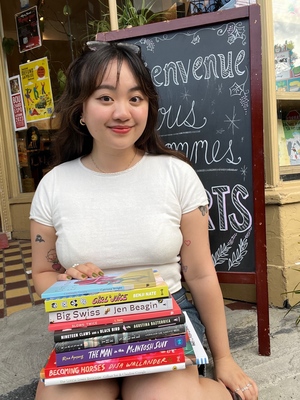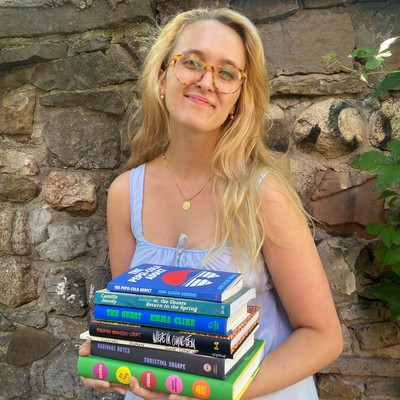This shelf belongs to...Joe Ollmann!
January 9, 2017

Each month, Librairie Drawn and Quarterly invites a local author or artist to curate a shelf in the store. This January, we bring you recommendations from Joe Ollmann!
By his own account, Joe Ollmann was born ''on a Christmas tree farm some time before the festivities surrounding Expo '67.'' Despite these idyllic origins, Ollmann has spent much of his adult life writing comics that eloquently deprecate his own physique, habits, and achievements. In 2007, these efforts were recognized by the Doug Wright Awards, where Ollmann took home "Best Book" for This Will All End in Tears. He was nominated for the same award again in 2012, for Mid-Life (published by Drawn & Quarterly!), which Ollmann described as his "break-out, feel-good, fun-time book."
Ollmann's latest book, due out January 24th from D&Q, is titled The Abominable Mr. Seabrook. It's a biography of William Seabrook, the journalist and travel writer who brought the word "zombie" into the English language, palled around with Aldous Huxley, Thomas Mann, Gertrude Stein, and Sinclair Lewis, smoked opium with Jean Cocteau, practiced black magick with Aleister Crowley, and collaborated with Man Ray and Salvador Dali. He also lived with Bedouin tribesmen, a Haitian witch doctor, and (reputedly) ate human flesh with cannibals. He was also an alcoholic and S&M enthusiast who committed suicide in 1945! Typically sunny Ollmann territory, in other words. Nevertheless, Seabrook was a famous bestseller in his lifetime but is almost unknown today. Ollmann makes the case that Seabrook's remarkable life deserves to be better known -- and understood.
Joe Ollmann currently lives in Hamilton, ON.
Joe Ollmann currently lives in Hamilton, ON.
All of Joe's picks will be 15% off for the month of January! Here's a sneak peak of what you'll find on his shelf:
Drop In by Dave Lapp
Drop In by Dave Lapp
This is short vignettes of a guy teaching art to little kids in a drop in centre in a diverse neighbourhood in Toronto. Dave takes on hard stories and childhood cruelty with unblinking frankness and a lot of heart. His art is a simplified, heavy-line iconic style that works well with his writing. I’d love for more people to read Dave’s work.
It’s a Good Life if You Don’t Weaken by Seth
It’s a Good Life if You Don’t Weaken by Seth
This was the first book I read by Seth. It was a revelation and I fell in love with his work. This book is younger Seth, still smoking and pre-Tania and kind of a mess with no solace but the lure of old cartoon books. This book is beautifully drawn and filled with lovely weird details. The guy’s not a national treasure for no reason!
The Road to Wigan Pier by George Orwell
The Road to Wigan Pier by George Orwell
Orwell meant so much to me as a kid, but he still resonates for me now I’m old. He was the person who taught me more about cynicism than perhaps even Mad Magazine did: you can be a socialist and hate socialism…wha…?? This is one of his less rock star titles, but still my favourite, as he travels around England reporting on the living conditions of the poor.
The Greatest of Marlys by Lynda Barry
The Greatest of Marlys by Lynda Barry
As a young man, I had to buy the Toronto free paper Now Magazine in Hamilton for a dollar every week, just so I could cut out and save every Ernie Pook’s Comeek. Lynda Barry is probably the best writer of stories in comics there is. She does funny, she does sad, mostly overlapping. There’s a kindness and goodness that permeates all of her work. I love her and my daughters love her and I’m so glad that all her work is being reprinted in proper form.
The Monk by Matthew Gregory Lewis
The Monk by Matthew Gregory Lewis
This is an insane book. Lewis was 19 when he wrote this in 1796. It has cross-dressing monks, murder, corruption of innocence, and the devil appears in physical form. It’s the story of the most pious monk in the world who really falls off his pedestal. Incredibly readable with a million diversions. One of my all-time favourite books.
My Lunches with Orson by Peter Biskind
My Lunches with Orson by Peter Biskind
This is literally transcripts of recordings made by Henry Jaglom of his daily lunches with Orson Welles in the 80s. He’s still trying to make films and financing it by appearing on Loveboat and such. It’s sad, funny and the brilliance of Orson shines through. This book feels like Boswell recording Johnson, Welles is that kind smart and I hate that he’s reduced to the fat drunk guy in the frozen vegetable commercials on Youtube, this guy did great things and could have done more. Simon Callow’s 3 volume (so far) biography of Welles is also incredible.
The Autobiography of Malcolm X as told to Alex Haley
The Autobiography of Malcolm X as told to Alex Haley
Again, one of those book that meant a lot to me when I was young, but holds up every time I’ve re-read it. Everyone today should read this book. His life story itself is fascinating and tragic, but the journey from hustler to statesman is epic. This was one of the greatest speakers the world has ever known (watch some of his speeches on youtube!).
Fatherland by Nina Bunjevac
Fatherland by Nina Bunjevac
This book is incredible. Nina draws like Old Masters good, like Albrecht Durer good. And she writes equally well. Oh, and the the story, which is autobiographical, of her terrorist father getting himself blown up, makes most autobio comics about sad people drawing comics in coffee shops look pretty tepid. Though the book sold a ba-zillion copies and in every language, we may never see the promised sequel, cause Nina wanted to make a porny comic based on the Tourner film The Cat People!
I Never Liked You by Chester Brown
I Never Liked You by Chester Brown
This book is so full of emotion both repressed and overtly shown between the lines. Chester’s got the most unique style of any cartoonist but you can still see subtle influences of a lot of old master cartoonists in his drawings. Incredibly honest to an often painful fault, Chester’s memoir of growing up and the haunting demise of his emotionally disturbed mother is my favourite of all his books. Another national treasure! Canada's Mount Rushmore should be stone heads of Julie Doucet, Chester, Seth and Collier.
Fates and Furies by Lauren Groff
Fates and Furies by Lauren Groff
This was both President Obama’s and my favourite fiction book from 2015. The story of a marriage told from two perspectives in each half of the book. One character is a playwright and Groff’s synopsis of the plays are very real and evocative, reminding me of Auster whipping out a million unrealized story ideas in his books. I almost didn’t read this book because I thought the cover looked designed to attract older women readers! I apologize! Profusely!


